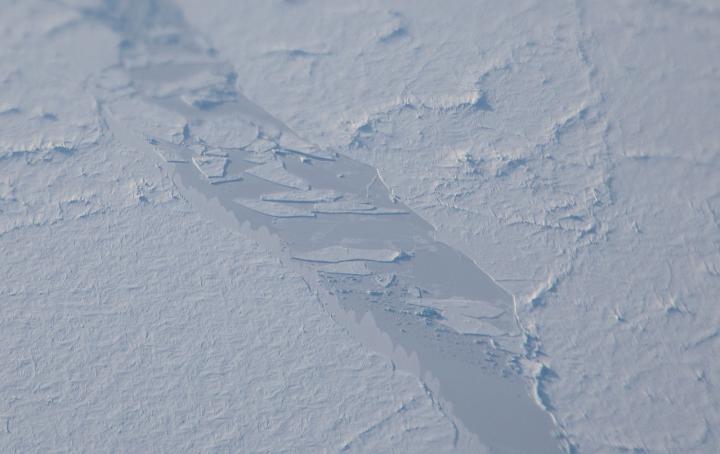Laser precision: NASA flights, satellite align over sea ice

This is a refrozen sea ice lead in the Arctic Ocean. Credit: NASA/Jeremy Harbeck
“If you look at the height profiles from ICESat-2 and IceBridge, you can tell that they're almost the same,” said Ron Kwok, a sea ice scientist at NASA's Jet Propulsion Laboratory in Pasadena, California, and lead author of the new study. “It's a good pitch for the quality of the ICESat-2 data.”
ICESat-2 uses its laser instrument to measure the heights of Earth's surface, focusing on the glaciers, ice sheets and sea ice in the planet's polar regions. When it launched on Sept. 15, 2018, scientists were poised to take measurements from planes and on the ground to check against the satellite's data, helping to and ensure the accuracy of the measurements from orbit.
The Operation IceBridge team has been flying campaigns over Greenland and Antarctica for a decade, and once ICESat-2 was in orbit they adjusted several missions to fly along the same path as the satellite. When they flew over ice sheets it was relatively straightforward, since the masses of ice don't gain or lose much height over a day or two, or even a week or two.
Sea ice, however, is pushed around by winds and ocean currents. If IceBridge flew along an ICESat-2 orbit track an hour after the satellite passed, it could be measuring completely different ice. So IceBridge mission scientist John Sonntag had to calculate where and when ICESat-2 was going to be over a specific spot in the Arctic ocean, and how to navigate the plane to be there at the exact same time – preferably with low winds, and definitely with no clouds to block ICESat-2's view.
“He was able to nail it,” Kwok said. “He was able to get to that part of the Arctic so there's almost zero time lag between ICESat-2 and the airplane.”
When Kwok and his colleagues used computer programs to line up the two datasets, they saw the same ridges, bumpy surface, and open water in both elevation profiles. With four flights worth of data comparisons, over more than 600 miles (1,000 kilometers), the two sets of height measurements closely match each other: Researchers would call an exact match 1.0, and these were correlated to more than 0.95.
Sea ice height profiles from ICESat-2 can tell scientists whether the ice is a newly formed, smooth surface or an older, rougher section. The key measurement from ICESat-2, however, is how high the ice surface is above the open water, called freeboard. If scientists know that number, they can calculate the thickness – which isn't directly measured from satellite data. When Kwok and his colleagues compared freeboard measurements from ICESat-2 and Operation IceBridge's Airborne Topographic Mapper instrument for the April flights, they were within 0.8 to 1.6 inches (2 to 4 centimeters) of each other.
With additional flights over land and sea ice in both Greenland and Antarctica this fall, Operation IceBridge is continuing to help assess ICESat-2 data, along with other efforts including the third year of an Antarctic ground traverse along a section of the 88 degree South line of latitude.
For more information, visit: nasa.gov/icesat-2 or icesat-2.gsfc.nasa.gov
Media Contact
All latest news from the category: Earth Sciences
Earth Sciences (also referred to as Geosciences), which deals with basic issues surrounding our planet, plays a vital role in the area of energy and raw materials supply.
Earth Sciences comprises subjects such as geology, geography, geological informatics, paleontology, mineralogy, petrography, crystallography, geophysics, geodesy, glaciology, cartography, photogrammetry, meteorology and seismology, early-warning systems, earthquake research and polar research.
Newest articles

Scientists transform blood into regenerative materials
… paving the way for personalized, blood-based, 3D-printed implants. Scientists have created a new ‘biocooperative’ material based on blood, which has shown to successfully repair bones, paving the way for…

A new experimental infection model in flies
…offers a fast and cost-effective way to test drugs. Researchers at the Germans Trias i Pujol Research Institute and Hospital have reinforced their leading role in infectious disease research by…

Material developed with novel stretching properties
KIT researchers produce metamaterial with different extension and compression properties than conventional materials. With this material, the working group headed by Professor Martin Wegener at KIT’s Institute of Applied Physics…



